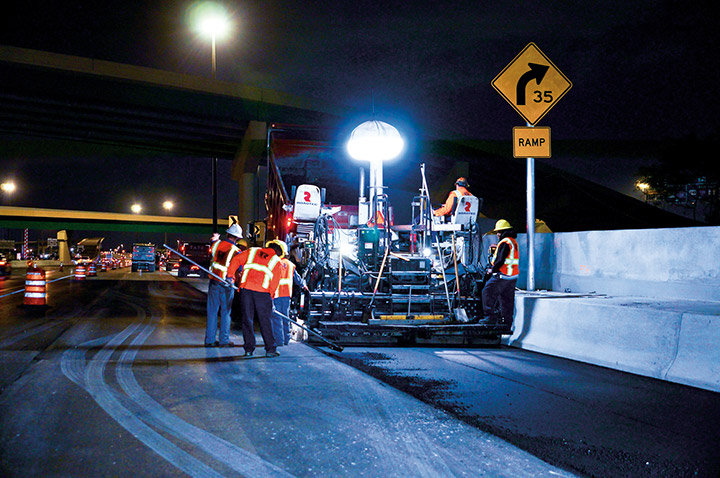Make Best Use Of Room Performance with Hot Mix Asphalt Angled Parking Lot Solutions
Make Best Use Of Room Performance with Hot Mix Asphalt Angled Parking Lot Solutions
Blog Article
Unlocking the Keys of Warm Mix Asphalt Innovation
Discovering the midsts of hot mix asphalt technology uncovers a globe where meticulous processes and accurate formulas merge to form our roadways and framework. The blend of accumulations, binders, and fillers isn't merely a building job but a critical orchestration of durability and performance. As we peer into the intricate dance of parts, a tapestry of strength and sustainability unfolds. Yet what lies under this surface of asphaltic proficiency, and what secrets wait to be introduced in the realm of leading advancements?
Significance of Hot Mix Asphalt
Hot Mix Asphalt plays an important duty in modern-day facilities development as a result of its durability and cost-effectiveness. As the most typically made use of leading material for roadways, highways, and car park, Hot Mix Asphalt supplies an array of benefits that contribute to its relevance in construction tasks. One vital advantage is its ability to hold up against hefty web traffic lots and severe climate condition, offering a trusted and resilient surface area for transportation networks. Additionally, Warm Mix Asphalt is economical in both preliminary construction and lasting upkeep, making it a preferred selection for several infrastructure projects.
The longevity of Warm Mix Asphalt stems from its structure, which consists of accumulations, binder, and filler products that are very carefully picked and blended to fulfill certain efficiency needs. On the whole, the relevance of Hot Mix Asphalt in facilities advancement can not be understated, as it continues to be a cornerstone of modern-day building methods.
Parts of Asphalt Mixes
The make-up of asphalt mixes consists of meticulously selected accumulations, binder, and filler materials that are essential for attaining certain performance requirements. Aggregates are the main component of asphalt blends, supplying stamina and security. The binder, commonly bitumen or asphalt concrete, holds the accumulations together and supplies adaptability and durability to the mix.
The mix and percentage of these elements play a significant duty in figuring out the high quality and efficiency of the asphalt mix. Designers very carefully create the mix to satisfy particular requirements, thinking about elements like website traffic quantity, climate problems, and sidewalk life-span. Proper choice and harmonizing of aggregates, binder, and fillers are crucial for producing sturdy, durable asphalt sidewalks.
Combining and Manufacturing Methods

As soon as the accumulations are chosen, the binder, frequently asphalt concrete, is added to bind the materials with each other. The binder's quality and amount significantly influence the mix's stamina, resistance, and flexibility to environmental aspects. In addition, fillers like moisturized lime or Portland concrete might be incorporated to enhance specific features of the asphalt mix, such as its workability or dampness resistance.
Throughout manufacturing, the accumulations and binder are heated up, typically in between 250-325 ° F(121-163 ° C ), to facilitate mixing and make certain correct coating of the accumulations. The blending procedure must be comprehensive to accomplish a homogeneous mixture that advertises the wanted efficiency features of the asphalt. Numerous methods, such as set blending or drum blending, are used to accomplish constant and high-quality asphalt blends for building and construction tasks.
Aspects Impacting Asphalt Performance
Variables affecting asphalt performance include a variety of variables that affect the sturdiness, durability, and overall top quality of asphalt sidewalks. One crucial element is the top quality of materials utilized in the asphalt mix.
:max_bytes(150000):strip_icc()/low-section-of-man-working-758486719-59da6d0a054ad90010617854.jpg)
Ecological conditions likewise influence asphalt efficiency. Temperature level variations, dampness infiltration, and website traffic loads can all impact the structural integrity of the sidewalk. Layout factors to consider, such as sidewalk thickness and drainage, are important in making sure the lasting efficiency of the asphalt sidewalk. By thoroughly considering these contractors, designers and aspects can enhance asphalt performance and boost the service life of sidewalks.
Sustainable Practices in Asphalt Technology

In addition, the development of warm-mix asphalt (WMA) modern technologies has actually obtained grip over the last few years. WMA allows for the production and placement of asphalt mixes at lower temperature levels contrasted to typical hot-mix asphalt, causing lowered energy intake and greenhouse gas emissions. The use of porous asphalt blends can assist alleviate stormwater runoff issues by allowing water to penetrate via the Learn More pavement and right into the ground, advertising all-natural water filtration and charge processes. By applying these sustainable techniques, the asphalt sector can add to developing a more durable and environmentally pleasant framework network.
Final Thought
To conclude, warm mix asphalt modern technology plays an essential function in modern-day infrastructure growth due to its sturdiness and cost-effectiveness. By thoroughly stabilizing parts, utilizing proper blending methods, and considering numerous factors, designers can develop top notch asphalt blends that withstand hefty website traffic loads and extreme weather. Embracing lasting practices, such as making use of warm-mix technologies and recycled materials, better boosts the environmental friendliness of asphalt technology.
Blending and manufacturing techniques in warm mix asphalt technology entail the specific combination and processing of aggregates, binder, and fillers to create a resilient and high-performance asphalt mix.Variables influencing asphalt performance encompass a variety of variables that impact the longevity, long life, and total high quality of asphalt sidewalks. Sustainable practices in asphalt modern technology include different campaigns intended at lowering the ecological effect of asphalt production and paving procedures. By incorporating recovered asphalt pavement (RAP) and recycled see this asphalt shingles (RAS) right into brand-new asphalt mixes, the industry can considerably minimize the consumption of raw materials and energy, while also decreasing land fill waste.
WMA allows for the production and placement of asphalt mixes at lower temperatures compared to conventional hot-mix asphalt, resulting in reduced power usage and greenhouse gas emissions.
Report this page